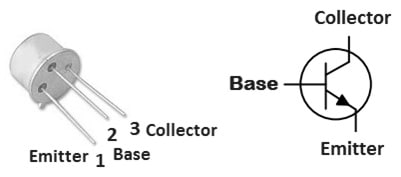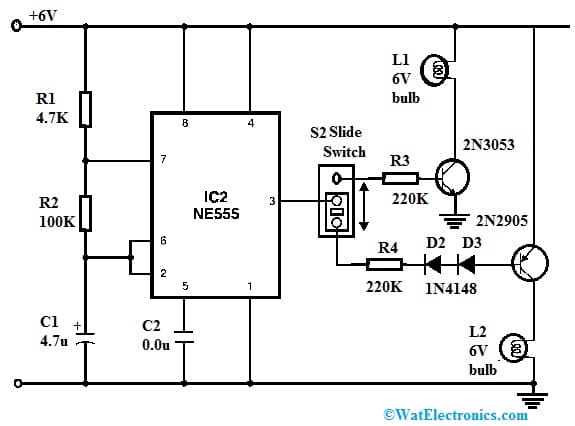Transistors that are made completely with metal bodies have been available for quite a long time. The 2N3053 transistor is one of them and is a very popular metal can transistor that is available in the TO-39 package, which is bigger as compared to the TO-18. The transistor has quite interesting characteristics so it is capable of achieving stably in very low & high-temperature conditions. This transistor is mainly designed to utilize in the applications of power oscillators, audio amplifiers & general purpose applications. This article provides brief information on the 2N3053 transistor, pin configuration, specifications, and its applications.
What is a 2N3053 Transistor?
The 2N3053 is an NPN-type Silicon transistor that has a P-doped semiconductor that exists among the two N-doped layers. This transistor is used in switching and amplifying applications. This transistor is a BJT and so has three terminals and is available in a TO-39 metal can package. This NPN transistor has low leakage current, beta value, low capacity & high breakdown voltage which are very helpful above a broad range of current.
This transistor is known as a current-controlled device because, at the base terminal, a small amount of current is used for controlling a large amount of current at the two terminals of the emitter & collector. This transistor is called BJT because conduction can be done simply through the movement of both charge carriers although the majority of charge carriers of this transistor will be electrons.
Working
The working of the 2N3053 NPN transistor is; that whenever there is no voltage supply provided to the base terminal of this transistor then the remaining emitter and collector terminals will be reverse biased which is called left open. When a positive voltage supply is provided to the base terminal of this transistor, a small amount of current will start to supply from the base terminal to the emitter & this transistor will reach its on state. So this transistor’s maximum gain is 50 and it decides the device’s amplification factor.
When this 2N3053 transistor is biased then it allows 700mA of maximum current with 5W of power capacity across collector emitter (CE) Junction, and this state is called as saturation state. We already know that a transistor is known as current controlled device thus whenever the base current of this transistor is detached then this transistor will move to its off state, in this condition, this transistor will work in the cut-off region thus there is no flow of current throughout the base-emitter (BE) junction.
Pin Configuration:
The pin configuration of the 2N3053 NPN transistor is shown below. This transistor includes three pins which are discussed below.

2N3053 Transistor Pin Configuration
Pin-1 (Emitter): This terminal emits electron charge carriers into the primary PN junction.
Pin-2 (Base): The base terminal is used to control the transistor biasing.
Pin-3 (Collector): This terminal collects the electron charge carriers which are emitted from the emitter.
Features & Specifications:
The features and specifications of the 2N3053 NPN transistor include the following.
- It is an NPN Bipolar junction transistor.
- It is available in the TO-39-3 package.
- The polarity of this transistor is NPN.
- It has a single configuration.
- It includes three pins.
- The mounting type is through-hole.
- Power dissipation is 5W.
- The type of product is bipolar power.
- Its height x length x width is 6.60 mm x 9.39 mm x 9.39 mm.
- Its operating temperature ranges from -65°C to 200°C.
- Its emitter to base voltage maximum is 5V.
- Its maximum DC current gain or hFE is 50.
- Its maximum base current or IB is 15mA.
- Its operating frequency maximum is 100Mhz.
- Its collector capacitance is <15pF.
- Its collector current maximum is 0.7A.
- Its transition frequency is above 100 MHz.
- Its input capacitance is <80pF.
- Its collector current continuously is IC is 700mA.
- Its collector-to-base voltage maximum or Vcb is 80V.
- Its collector-to-emitter voltage maximum is 40 V.
- Its collector-to-base voltage maximum is 60 V.
- Its DC current gain maximum is 25 at 15A.
- Its collector-to-emitter saturation voltage is 1.4V at 15mA.
- Its maximum base-emitter saturation voltage is 1.7V at 15mA.
Equivalent & Replacements
Equivalent 2N3053 transistors are; SL100, BC108, 2N2219, 2N5321, 2N5210, BC140, BC440, BC141, BC441, etc. Replacement of 2N3053 transistors are; 2N5327, 2N5210, 2N3725 and 2N5327. Before replacing a transistor with its equivalents few points needs to be considered. Read on Replacing transistors in electronics circuits to know about it.
How to use a 2N3053 Transistor securely in a Circuit for a Long Time?
To use this transistor very securely within a circuit for a long time this transistor must follow the safe operating guidelines which are discussed below.
- This transistor should not be used to its absolute maximum ratings & stay always below 20%.
- The maximum collector to the emitter (CE) voltage of this transistor is 40V thus the driven load should not go above 32Volts.
- The maximum collector current is 700mA so do not drive any load above 560mAmps.
- Its operating and storage temperature must range from -65°C to +200 °C.
- A proper heat sink must be used always with this NPN transistor.
- a proper base resistance is mostly required to prevent it from any damage due to voltage differences. To know how to choose it read on Choosing Base Resistance for Transistors in Electronic Circuits.
Traffic Baton Circuit with Bulb Flasher
The traffic baton circuit with the bulb is shown below. This traffic baton circuit is available in two versions like; traffic baton using LED flasher & traffic baton using bulb flasher but both the circuits work with a 6V, 4.5Ah rechargeable battery.
The required components to make this traffic baton circuit mainly include; resistors R1- 4.7K, R2-100K, R3 and R4-220K, NE555 IC, D2 and D3 diodes – 1N4148, capacitors C1-4.7u, C2-0.0u, S2 slide switch, transistors T1 & T2; N3053 or BD139 & 2N2905 or BD140 and L1 & L2 – 6V bulbs. Connect the circuit as per the circuit diagram shown below.

Traffic Baton Circuit using Bulb Flasher
Working
This circuit uses an NE555 timer which is connected as an astable multivibrator with approximately 1.5 Hz frequency and also two 2N3053 & 2N2905 bulb-driver transistors for lighting up the flashing bulb. The flashing bulb’s “on” time is approximately 344 milliseconds whereas “off” time is approximately 329 milliseconds.
The two diodes in the circuit are connected in series with the 2N2905 transistor’s base terminal to enhance the forward voltage to make sure that whenever 2N3053 is conducting, 2N2905 is cut off. Here, the S2 slide switch is used for changing the flashing bulb’s color condition.
This simple circuit can be built on a separate PCB. Locate the LED flasher within a transparent acrylic pipe. This bulb flasher circuit is enclosed in an additional transparent acrylic pipe. For suitable colour emissions, slide switches, green & red acrylic sheets are utilized.
The battery of this circuit is clipped to the waistband of the operator. This circuit is very helpful for the police to control the traffic through hand signals in dark conditions or at night time. Generally, the hand signals are not visible at the night time, so a traffic baton is required as a direction indicator with illumination.
Before selecting any transistor within a suitable application, we need to consider different factors. To know more, please click this link How to Select a Transistor. The transistors can also be interfaced with a microcontroller. Read on Interfacing with a microcontroller to know about it but before interfacing few precautions need to be taken check on Precautions to be taken before connecting a transistor to the microcontroller.
2N3053 Transistor Applications
The applications of a 2N3053 transistor include the following.
- The 2N3053 transistor is used mainly for general-purpose amplification & switching.
- This transistor is a flexible device and is suitable for different applications due to its large bandwidth and high frequency.
- This transistor can be used as a switch. So the switch will be turned OFF whenever there is no voltage supply at the base terminal and this switch will be turned ON if the voltage is applied at the base terminal.
- These transistors are used in flashers and LED dimmers.
- It is used in switching applications.
- These are used in high-frequency switching.
- These transistors are used in signal amplification, power supplies, switching circuits, low-power audio amplifiers, RF circuits, FM radio, low-current motor driver circuits, etc.
- 2N3053 transistors are used in different electronic applications like; power supply circuits, low-power audio amplifiers & electronics applications.
Please refer to this link for the 2N3053 Transistor Datasheet.
Thus, this is an overview of the 2N3053 transistor, pinout, features, specifications, circuit, working, and applications. This is an NPN-type bipolar junction transistor or BJT which is mainly designed for switching & amplification purposes within various electrical and electronic circuits. Here is a question for you, what is a 2N5327 transistor?